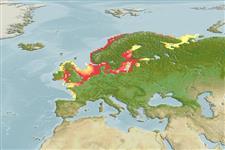Preferred temperature (Αναφ.
123201): 5.5 - 12, mean 9.6 °C (based on 1010 cells).
Phylogenetic diversity index (Αναφ.
82804): PD
50 = 0.5625 [Uniqueness, from 0.5 = low to 2.0 = high].
Bayesian length-weight: a=0.00417 (0.00269 - 0.00646), b=3.18 (3.05 - 3.31), in cm total length, based on LWR estimates for this species & (Sub)family-body (Ref.
93245).
Τροφικό Επίπεδο (Αναφ.
69278): 3.5 ±0.42 se; based on food items.
Ελαστικότητα (Αναφ.
120179): Μεσαίο(α), ελάχιστος χρόνος για διπλασιασμό πληθυσμού 1,4 - 4,4 έτη (K=0.15-0.25; tm=2-4; tmax=10; Fec=10,000).
Fishing Vulnerability (Ref.
59153): Moderate vulnerability (43 of 100).
🛈
Climate Vulnerability (Ref.
125649): High to very high vulnerability (72 of 100).
🛈
Nutrients (Ref.
124155): Calcium = 43.2 [16.7, 100.8] mg/100g; Iron = 0.467 [0.228, 1.197] mg/100g; Protein = 17.5 [14.5, 20.0] %; Omega3 = 0.804 [0.404, 1.637] g/100g; Selenium = 13.8 [6.4, 30.4] μg/100g; VitaminA = 25.1 [9.0, 74.9] μg/100g; Zinc = 0.704 [0.457, 1.105] mg/100g (wet weight);
